The AMD 2nd Gen Ryzen Deep Dive: The 2700X, 2700, 2600X, and 2600 Tested
by Ian Cutress on April 19, 2018 9:00 AM ESTCPU Rendering Tests
Rendering tests are a long-time favorite of reviewers and benchmarkers, as the code used by rendering packages is usually highly optimized to squeeze every little bit of performance out. Sometimes rendering programs end up being heavily memory dependent as well - when you have that many threads flying about with a ton of data, having low latency memory can be key to everything. Here we take a few of the usual rendering packages under Windows 10, as well as a few new interesting benchmarks.
All of our benchmark results can also be found in our benchmark engine, Bench.
Corona 1.3: link
Corona is a standalone package designed to assist software like 3ds Max and Maya with photorealism via ray tracing. It's simple - shoot rays, get pixels. OK, it's more complicated than that, but the benchmark renders a fixed scene six times and offers results in terms of time and rays per second. The official benchmark tables list user submitted results in terms of time, however I feel rays per second is a better metric (in general, scores where higher is better seem to be easier to explain anyway). Corona likes to pile on the threads, so the results end up being very staggered based on thread count.
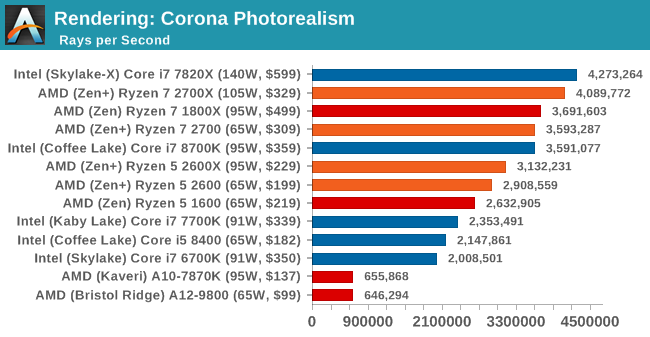
Blender 2.78: link
For a render that has been around for what seems like ages, Blender is still a highly popular tool. We managed to wrap up a standard workload into the February 5 nightly build of Blender and measure the time it takes to render the first frame of the scene. Being one of the bigger open source tools out there, it means both AMD and Intel work actively to help improve the codebase, for better or for worse on their own/each other's microarchitecture.
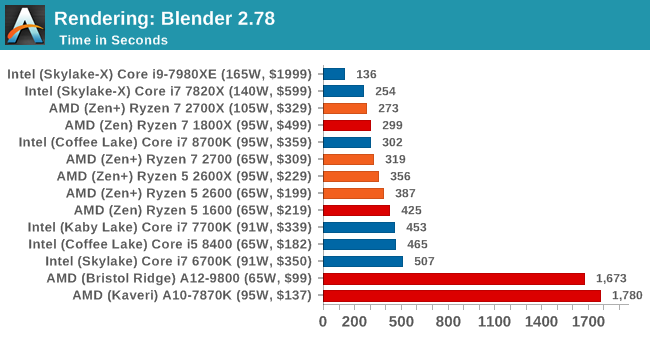
This is one multi-threaded test where the 8-core Skylake-based Intel processor wins against the new AMD Ryzen 7 2700X; the variable threaded nature of Blender means that the mesh architecture and memory bandwidth work well here. On a price/parity comparison, the Ryzen 7 2700X easily takes the win from the top performers. Users with the Core i7-6700K are being easily beaten by the Ryzen 5 2600.
LuxMark v3.1: Link
As a synthetic, LuxMark might come across as somewhat arbitrary as a renderer, given that it's mainly used to test GPUs, but it does offer both an OpenCL and a standard C++ mode. In this instance, aside from seeing the comparison in each coding mode for cores and IPC, we also get to see the difference in performance moving from a C++ based code-stack to an OpenCL one with a CPU as the main host.

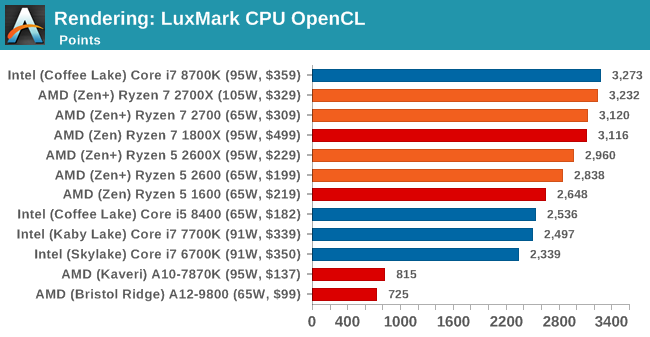
POV-Ray 3.7.1b4: link
Another regular benchmark in most suites, POV-Ray is another ray-tracer but has been around for many years. It just so happens that during the run up to AMD's Ryzen launch, the code base started to get active again with developers making changes to the code and pushing out updates. Our version and benchmarking started just before that was happening, but given time we will see where the POV-Ray code ends up and adjust in due course.
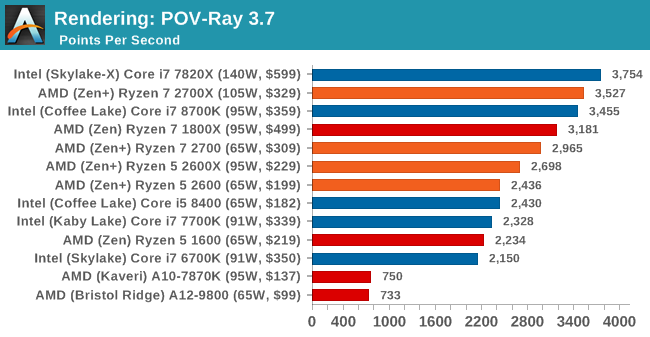
Cinebench R15: link
The latest version of CineBench has also become one of those 'used everywhere' benchmarks, particularly as an indicator of single thread performance. High IPC and high frequency gives performance in ST, whereas having good scaling and many cores is where the MT test wins out.
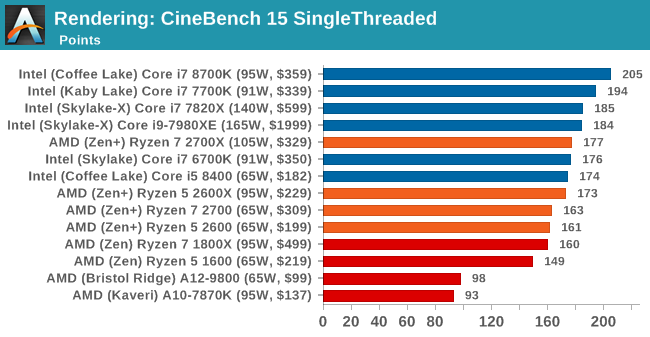
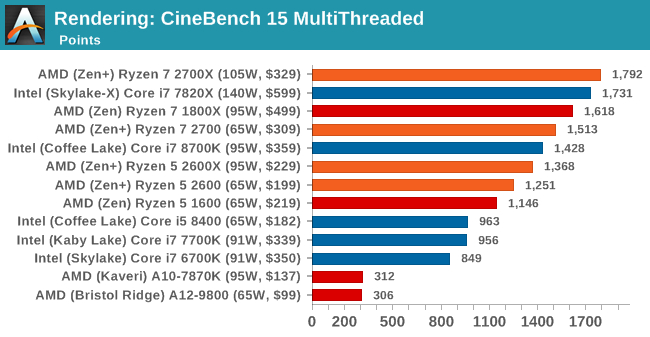
Intel is still the single thread champion in benchmarks like CineBench, but it would appear that the Ryzen 7 2700X is now taking the lead in the multithreaded test.










545 Comments
View All Comments
mapesdhs - Monday, May 14, 2018 - link
You know what will happen there though, yet more accusations of conspiracy, etc.lfred - Wednesday, April 25, 2018 - link
Could anyone confirm the Wraith Prism cooler height 9.4cm , (and therefore wont fit a Silverstone Raven Z Mini-ITX case ) . thank youpsychok9 - Wednesday, April 25, 2018 - link
Hello Ian, is there any news this week?ET - Wednesday, April 25, 2018 - link
I'm still waiting for the StoreMI page.Sx57 - Wednesday, April 25, 2018 - link
Well i am still waiting for anandtech updating the article.i am very interested to know how ryzen beat coffelake so well.i believe anandtech review is perfomed rightly but i wanna know what is actually wrong with other reviews that make intel winner in some games.it seems not to be the security patches related.FaultierSid - Wednesday, April 25, 2018 - link
Did they just silently switch out all gaming benchmarks? Intel 8700K now winning across the board.rocky12345 - Wednesday, April 25, 2018 - link
Yep they sure did they must have redone the tsts but this time turned on MCE for Intel and upped the memory clock to at least 3200MHz for Intel as well to see those kinds of gains in games from the old charts from last week. If they decide to explain it they will spin it that oh they had the wrong data points in the charts for Intel...lolTEAMSWITCHER - Wednesday, April 25, 2018 - link
Yes .. at 1080P. The 4K gaming results are rather mixed. So the original conclusion still stands for me. The AMD Ryzen 2700X is roughly on par with the 8700K at 4K gaming, and pulls ahead in productivity applications.RafaelHerschel - Wednesday, April 25, 2018 - link
Here is how I see it, at 1080p the new Ryzen results are good enough for 60 FPS gaming. The 2600 (non-x model) sometimes drops below 60 FPS but for a system that is equally used for productivity and gaming, I can certainly live with that. For a system that is mainly used for gaming, I still prefer Intel, but by a slimmer margin than before.mapesdhs - Monday, May 14, 2018 - link
You are hereby awarded the Sensible Chap medal for mentioning 60Hz gaming in at least a non-negtive manner. 8) A few pages back, one guy described anything below 144Hz as useless.